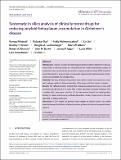Systematic in silico analysis of clinically tested drugs for reducing amyloid‐beta plaque accumulation in Alzheimer's disease
Author(s)
Madrasi, Kumpal; Das, Raibatak; Mohmmadabdul, Hafiz; Lin, Lin; Hyman, Bradley T; Lauffenburger, Douglas A; Albers, Mark W; Rissman, Robert A; Burke, John M; Apgar, Joshua F; Wille, Lucia; Gruenbaum, Lore; Hua, Fei; ... Show more Show less
DownloadPublished version (3.838Mb)
Publisher with Creative Commons License
Publisher with Creative Commons License
Creative Commons Attribution
Terms of use
Metadata
Show full item recordAbstract
INTRODUCTION: Despite strong evidence linking amyloid beta (Aβ) to Alzheimer's disease, most clinical trials have shown no clinical efficacy for reasons that remain unclear. To understand why, we developed a quantitative systems pharmacology (QSP) model for seven therapeutics: aducanumab, crenezumab, solanezumab, bapineuzumab, elenbecestat, verubecestat, and semagacestat. METHODS: Ordinary differential equations were used to model the production, transport, and aggregation of Aβ; pharmacology of the drugs; and their impact on plaque. RESULTS: The calibrated model predicts that endogenous plaque turnover is slow, with an estimated half-life of 2.75 years. This is likely why beta-secretase inhibitors have a smaller effect on plaque reduction. Of the mechanisms tested, the model predicts binding to plaque and inducing antibody-dependent cellular phagocytosis is the best approach for plaque reduction. DISCUSSION: A QSP model can provide novel insights to clinical results. Our model explains the results of clinical trials and provides guidance for future therapeutic development.
Date issued
2021Department
Massachusetts Institute of Technology. Department of Biological EngineeringJournal
Alzheimer's and Dementia
Publisher
Wiley